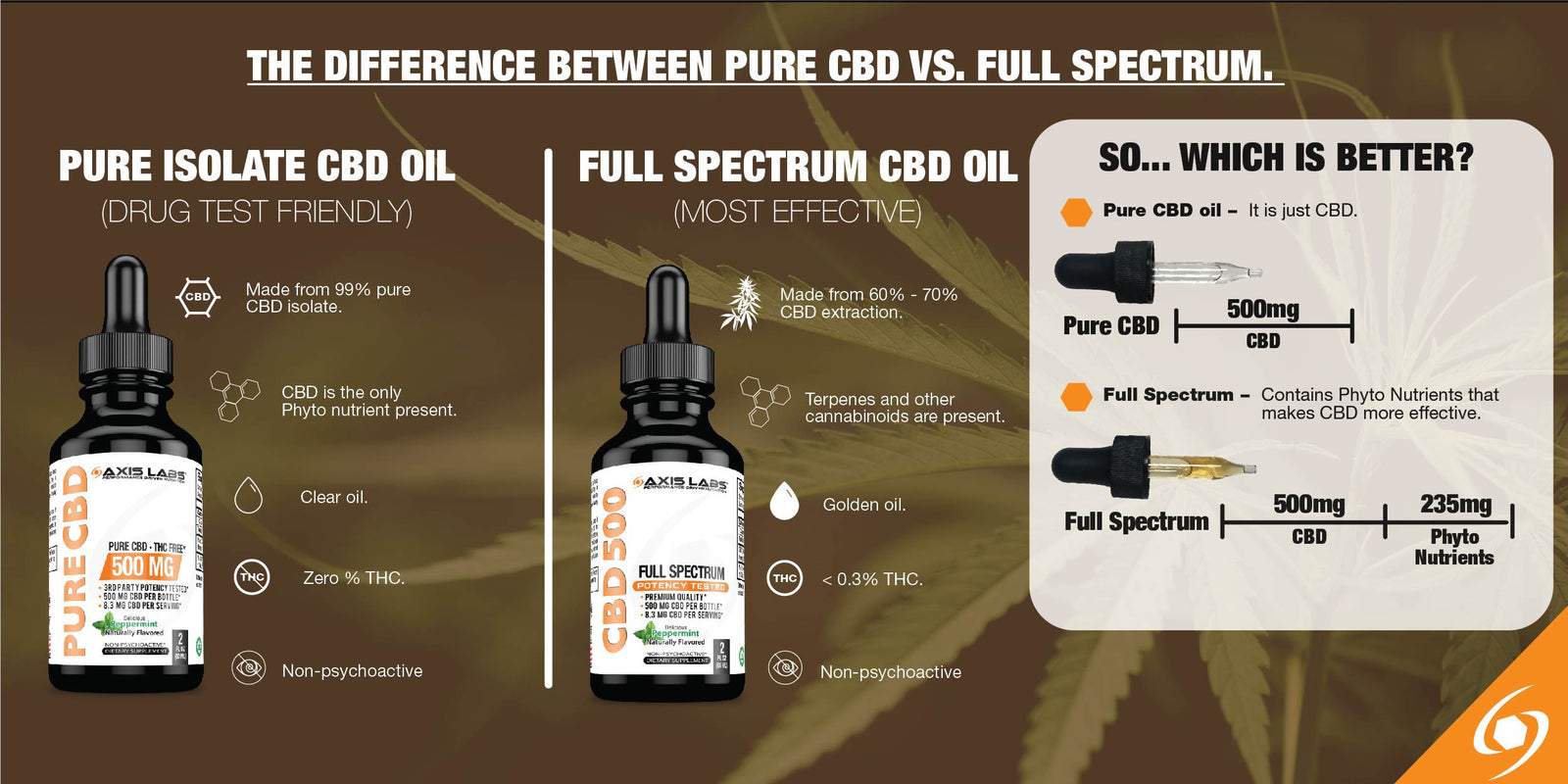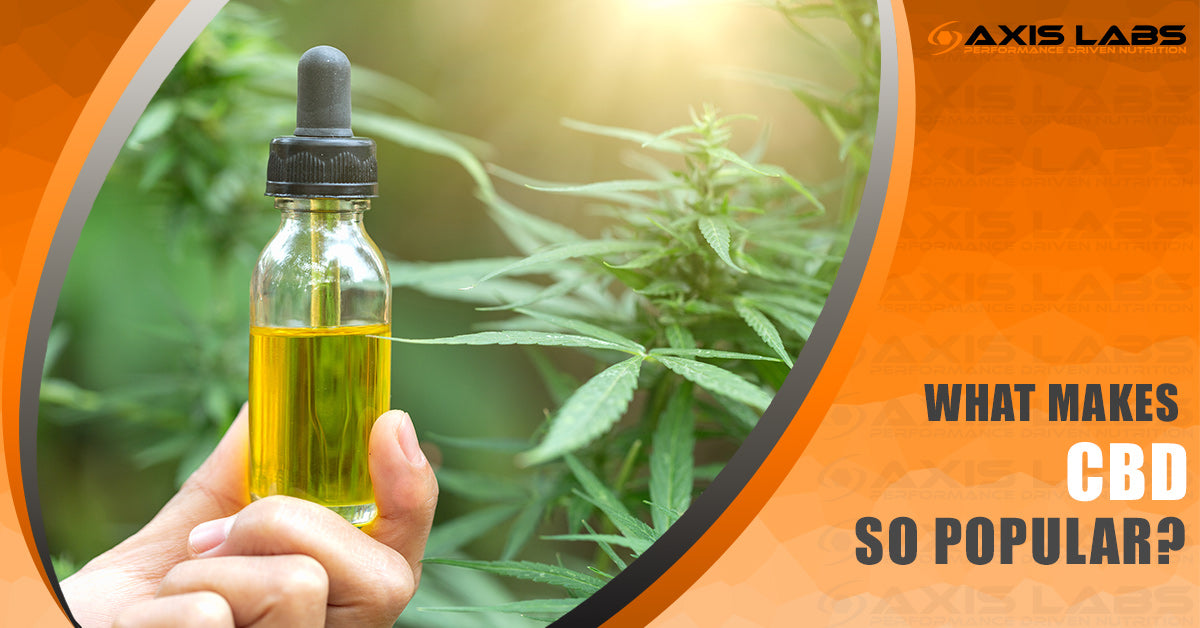Your Cart is Empty
FREE SHIPPING ON ORDERS +$49
FREE SHIPPING ON ORDERS +$49
CBD Isolate Vs. Full Spectrum CBD
5 min read

Cannabidiol (CBD) is only one of the over 80 known cannabinoids found in cannabis. Different cannabis species from various origins have been used in phytomedicine for thousands of years, particularly as anti-pain agents (analgesics) and for treating neuropathy.1
However, contemporary therapeutic uses of cannabis and CBD oil cover a much more diverse range, including:
- Anti-inflammatory benefits and free radical scavenging
- Neuroprotective properties
- Treating seizures
- Reducing anxiety and stress
- Enhancing immune function
- Promoting better sleep
While the whole spectrum of phytocannabinoids in cannabis has a unique set of applications and benefits, the major hindrance is the psychoactive effects of 9 -Tetrahydrocannabinol (THC).
While THC is the primary psychedelic component of marijuana, CBD and other non-psychoactive cannabinoids don’t bring about sensations of euphoria, nor are they intoxicating.
But how, you ask?
Cannabinoids from marijuana work by binding to receptors of the endogenous cannabinoid system (known as the “ECS” for short). Two types of ECS receptors have been characterized throughout the body: CB1 and CB2.
The euphoria and intoxicating properties of THC are triggered by activating CB1 receptors.
CBD, on the other hand, has a very low binding affinity for CB1 receptors (100-fold lower than THC), and even when it binds, the effects are essentially nonexistent. 2
Instead, CBD binds primarily to CB2 receptors and promotes a myriad of medicinal effects throughout the body.
This is ultimately why CBD isolate products have been booming in recent years. Before you presume that isolated CBD is best (for you) because it doesn’t contain any psychoactive cannabinoids, it’s imperative to understand the difference between pure CBD and full-spectrum CBD supplements.
What is CBD Isolate a.k.a. Pure CBD?
Cannabidiol (CBD) has been a major focus of clinical studies and scientific research in recent years, with no shortage of evidence backing its efficacy for healing the body in many different fashions.3
CBD isolate products are typically categorized as hemp products that contain 99% (or more) CBD and virtually no other phytochemicals. The most efficient way to isolate CBD is by CO2 extraction of hemp.4 The isolated CBD may then be put in capsules, gummies, or a carrier oil such as MCT oil.
Is CBD Isolate Safe?
Since it works through different mechanisms than THC, CBD has an entirely different safety profile. A recent meta-analysis that comprised 25 studies concluded that CBD is virtually non-toxic and free from adverse effects, even in exorbitant amounts.5
Will CBD Isolate Make You Fail a Drug Test?
In short: No, CBD isolate will not make you fail a drug test for marijuana (which assays your excretion of THC metabolites). This is one of the advantages to using a pure CBD supplement instead of a full-spectrum CBD product (which we will discuss more in the next section).
The World Anti-Doping Agency (WADA) has removed CBD from hemp oil (which is essentially the same thing as taking a CBD isolate supplement) from the list of prohibited substances. This means athletes, bodybuilders, and even people in the workplace no longer have to worry about using CBD isolate even if they are drug-tested for marijuana use.
On that note, let’s take a look at what full-spectrum CBD is and how it differs from pure CBD.
What is Full-Spectrum CBD?
Full-spectrum CBD, also sometimes called whole plant CBD or hemp oil, refers to products that contain CBD plus other cannabis-derived phytochemicals. The term “full spectrum” means the hemp is minimally refined and many of the phytocannabinoids and terpenoids remain in the final product.
While the actual composition of a full-spectrum CBD supplement will vary based on the cannabis species and origin used (and processing methods), the most notable phytocannabinoids are:
- Cannabidiol (CBD)
- Δ9 -Tetrahydrocannabinol (Δ9 -THC)
- Cannabichromene (CBC)
- Cannabigerol (CBG)
- Cannabinol (CBN)
- Cannabidivarin (CBDV)
- Tetrahydrocannabivarin (THCV)

Now, the good news is that hemp is naturally very low in THC (up to 0.3% concentration). As such, even though full-spectrum CBD contains THC, it’s only in trace amounts that will have negligible psychoactive effects.
In addition to phytocannabinoids, a cannabis plant contains upwards of 200 different terpenoids - which are actually the largest group of plant chemicals (over 20,000 have been characterized).6,7 In fact, the terpenoids in cannabis are what gives marijuana its unmistakable aroma. (To give you an idea of just how pungent terpenoids are, they typically make up less than 1% of the total constituents in cannabis.)
As such, you will be getting phytocannabinoids plus other cannabis-related compounds (like terpenoids) when you use a full-spectrum CBD product, like Axis Labs CBD Liquid Capsules.
Which is Better? Pure CBD vs. Full-Spectrum CBD
There is no straightforward answer to this question as both pure CBD and full-spectrum CBD have their own unique applications and benefits. As alluded to earlier, pure CBD tends to be the more practical and safer option if you are regularly drug tested for marijuana.
Even though full-spectrum CBD is very low in THC, if you use it regularly in large doses it could eventually raise a red flag on a drug test.
The advantages of full-spectrum CBD is that you get the synergistic ensemble of cannabis phytochemicals. Recent studies suggest that there may actually be more therapeutic benefits by consuming the many phytocannabinoids and terpenoids in cannabis together as opposed to taking isolated CBD.8
For example, one study compared the effects of five different cannabis extracts with equal CBD concentrations and varying profiles of non-CBD cannabinoids on seizures in mice.9 While all of the cannabis extracts significantly outperformed controls, the benefits between the extracts varied significantly, suggesting that the “minor” phytocannabinoids are more relevant than previously thought. Researchers have called this the “entourage effect”.
Nevertheless, the evidence supporting the many benefits of pure CBD are nothing short of overwhelming.
Whether you choose to use a pure CBD product or a full-spectrum CBD product, you can expect signiciant health benefits with very low risk of adverse effects. Ultimately, you should choose whichever one suits your lifestyle best.
In the coming years, you can expect research to continue investigating the unrivaled versatility cannabis extracts and CBD have to offer for our well-being and longevity.
References
- Russo, E. B. (2007). History of cannabis and its preparations in saga, science, and sobriquet. Chemistry & biodiversity, 4(8), 1614-1648.
- Pertwee RG. The diverse CB1 and CB2 receptor pharmacology of three plant cannabinoids: Δ9-tetrahydrocannabinol, cannabidiol and Δ9-tetrahydrocannabivarin. Br J Pharmacol. 2008 Jan; 153(2): 199–215.
- Maroon, J., Jeff Bost, P. A. C., Mathyssek, C., & Steelers, N. P. (2015). Nutritional & Medical Applications for Cannabidiol: Hemp Health Benefits without THC. Anti-Aging Therapeutics Volume XVII, 17.
- Grijó, D. R., Osorio, I. A. V., & Cardozo-Filho, L. (2019). Supercritical extraction strategies using CO2 and ethanol to obtain cannabinoid compounds from Cannabis hybrid flowers. Journal of CO2 Utilization.
- Bergamaschi et al. Safety and side effects of cannabidiol, a cannabis sativa constituent. Curr Drug Saf. 2011 Sep 1;6(4):237-49.
- Hendriks H, Malingré TM, Batterman S, Bos R. Mono- and sesqui-terpene hydrocarbons of the eseential oil of cannabis sativa. Phytochem. 1975;14:814–815
- Langenheim, J. H. (1994). Higher plant terpenoids: a phytocentric overview of their ecological roles. Journal of chemical ecology, 20(6), 1223-1280.
- Russo, E. B. (2018). The Case for the Entourage Effect and Conventional Breeding of Clinical Cannabis: No “Strain,” No Gain. Frontiers in plant science, 9, 1969.
- Berman P., Futoran K., Lewitus G. M., Mukha D., Benami M., Shlomi T., et al. (2018). A new ESI-LC/MS approach for comprehensive metabolic profiling of phytocannabinoids in Cannabis. Sci. Rep. 8:14280.
Also in Blog
Subscribe
Sign up to get the latest on sales, new releases and more …








